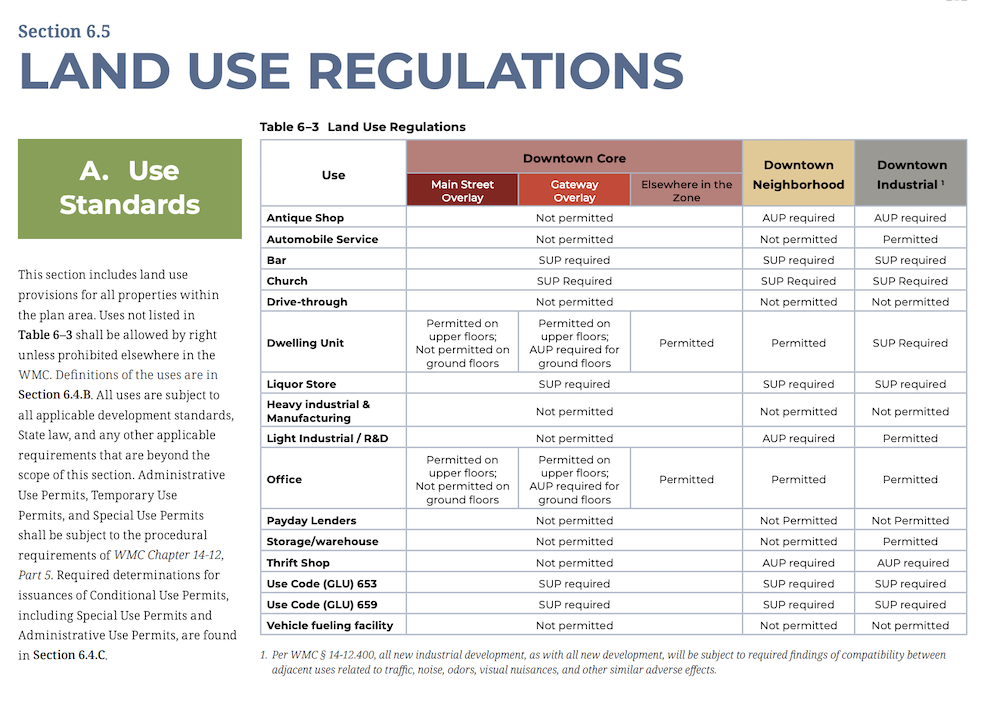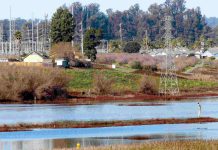
WATSONVILLE—The addition of around 4,000 new housing units over the course of 25 years. Two-way traffic on Lake and Beach streets. A completely reimagined industrial district on Walker Street. A network of pedestrian “paseos” that provides safe walking paths. The reduction of one lane on Main Street.
All of these ideas are part of a wishlist included in the draft of the Downtown Watsonville Specific Plan, a comprehensive planning document in the works for the past two years that will guide development downtown, reviewed by the city’s advisory committee at a virtual June 30 meeting.
A coalition of public officials, developers, business owners, nonprofit leaders and community organizers, the committee asked questions and gave feedback to the land-use consultant—Raimi + Associates—and City of Watsonville representatives at the gathering. Among their biggest areas of concern: The implementation of a “road diet” on Main Street, the proposed plan for Walker Street, the reduction of parking requirements and new land-use restrictions.
Getting around
The reduction of lanes, commonly referred to by planners as a “road diet,” on Main Street has been a hot topic since it was first introduced in 2019.
City staff says that the California Department of Transportation (Caltrans) is now not only tentatively on board with the project but is showing interest in using Watsonville as a “road diet” case study for other similar-sized communities that have a highway thoroughfare running through their downtown area.
“This is something that [Caltrans] would like to explore as part of their own project,” Watsonville Principal Planner Justin Meek said. “This would be something that the state would take on, would design, would fund, would build. It’s a good benefit for the city, itself, that the state would do on our behalf.”
The “road diet” included in the draft plan would change Main Street from four lanes to three lanes, with one lane in each direction and a middle turning lane and median. This would allow the addition of bike lanes and extended curbs and sidewalks along the street.

In order for that plan to move forward, the city must conduct an environmental impact report (EIR) to measure what effect it will have on the area. That EIR is underway and will be completed by the fall, according to Watsonville Community Development Department Director Suzi Merriam.
The road alterations don’t end there. The draft plan also suggests changing East Lake Avenue and East Beach Street in downtown to allow two-way traffic. Other streets such as Union, Brennan and Rodriguez are listed in the plan as roads that will need to be improved with bike lanes and larger sidewalks if the “road diet” is approved and traffic begins to spill into other areas.
Another ambitious plan included in the draft: A snaking pedestrian path linking the corridor through businesses, parks and housing developments. These so-called “paseos” would provide pedestrians with a way to navigate downtown without having to walk alongside street traffic.
These walkways would be prime locations for street art, outdoor dining and entertainment, the draft plan stated.
Industrial revolution
The draft also lists a handful of “opportunity sites” that, if redeveloped by the city or current landowners, could help address housing and economic development downtown. These sites include Watsonville police headquarters and the old city hall between Union and Main streets; the site that houses Ramos Furniture and Habitat for Humanity ReStore next to Bank of America on the corner of Main and 5th streets; and the city-owned parking lot off of Union Street between East Lake Avenue and East Beach Street.
The draft also suggests a wholesale makeover of several properties off Walker Street around the historic rail station. The stretch of Walker between Lake Avenue and Beach Street could accommodate opportunities for housing, and commercial development that, planners say, would fit the growing trend of placing more services around transportation.

Multiple committee members said that with the recent defeat of Measure D meaning plans for the rail trail will likely move forward, the redevelopment of sites across the street from the station is key for the city’s growth and environmental sustainability. But before that development occurs, committee members urged that the city address pedestrian safety in the area.
“Walkability between Walker to Main Street is a bit challenging for seniors and folks with mobility issues,” said committee member Felipe Hernandez, the former mayor of Watsonville and current candidate for Santa Cruz County Supervisor. “Here on Ford Street, I see people trying to walk with walkers, with baby carriages or on wheelchairs, and they have to move on the street because of telephone poles and narrow sidewalks.”
Parking & housing
In all, the draft plan projects that the corridor—with the initiatives identified—could add roughly 3,910 housing units over 25 years.
A big reason why this would be a possibility is the reduction of parking requirements for housing developments. Developers would no longer have to meet the current requirement of including at least two parking spaces for each studio, 1-bedroom and 2-bedroom units included in their project. In addition, affordable housing projects would be wholly exempt from minimum parking requirements, according to the draft plan.
The plan also suggests the city change parking time limits and pricing throughout downtown to funnel visitors to less-frequented spots and maximize the use of city-owned parking lots.
Another reason why the number of housing units could quickly increase: Projects in the core of downtown can now be built six stories tall—the maximum height falls to three stories as one moves away from Main Street into the adjacent neighborhoods to the east and west.

Businesses
The committee also had concerns about the land-use restrictions suggested in the draft plan, which states that thrift shops and antique shops would no longer be allowed downtown.
Raimi + Associates planner Simran Malhotra said that the draft plan excluded these businesses—which also include pawn shops—because there are already several of these establishments downtown.
“The desire is to encourage more restaurants, cafes and other types of uses within that core area,” Malhotra said, adding that current thrift and antique stores will be grandfathered into the corridor.

But local artist Judy Gittelsohn said that this could deter eclectic businesses from moving downtown. Gittelsohn, who last year established Studio Judy G downtown, highlighted the success of vintage houseware retailer SHEF in asking that these businesses be included in the corridor’s future.
“How do you allow for funky, little artisans to be in the town if you’re going to do this?” she asked. “I think what you’re doing here is cutting off your nose to spite your face.”
Feedback
The draft plan is open for public comment through July 14.
The advisory committee will have another virtual public meeting on July 21 in which it will go over the draft plan and the public feedback it received.
The plan, along with the EIR for the “road diet,” will likely go to the Watsonville City Council for approval in the late fall.
For information on the plan and to give feedback, visit cityofwatsonville.org/1626/Downtown-Specific-Plan.
















Tony Nunez,
My name is D.C. Kuhns, you don’t know me but I am very concerned about the citizens of Watsonville. I know the recent flooding along the Pajaro River was devastating for people, particularly the population of farm workers, many of whom lost everything.
My heart goes out to these folks.
I am a longtime fan of Watsonville, going back to 1974 when my wife and I were driving through Watsonville, with the intention of staying in Monterey. We stopped at the big Artichoke Sculpture in front of a local restaurant to buy artichoke hearts. Tasting them, we were in heaven. Ever since, we always stop in Watsonville, when we are traveling south to Monterey or Santa Barbara.
I have a colleague, William Samsel, an attorney who grew up in Watsonville. Bill has a law degree from UC Berkeley. Along with Bonnie Crosetti Larice, a citizen of Watsonville, Bill attended a recent (06/14) meeting of the City Council, where the flooding over the levees on the Pajaro River was discussed. Bill tried to speak at the recent meeting but the meeting chair wouldn’t give Bill the time. Bill and Bonnie wrote an article that will be published in the Pajaronian soon. It has already been accepted by an editor of the Pajaronian.
As for myself, I am a serial entrepreneur, starting companies in Delaware, NYC and California. Along with my brother, John Kuhns, we had a good run on Wall Street with public companies. My current start-up is Redwood Empire Clean Water, (RECW). RECW’s Mission is to provide clean, fresh water to citizens in small communities in Northern California whose current water systems are failing in their obligation to serve their residents with fresh water. Many of these disadvantaged communities are drinking polluted water laced with toxins like asbestos, lead and copper. I have attached a part of RECW’s Mission statement, (see below).
{Approximately 7,400 water systems exist in California. 5,000 of these water systems are controlled by larger, sometimes publicly owned water companies. Approximately 2,400 are small water systems serving communities with less than 500 residents.
Approximately 33% (815) of these small water systems are failing their obligation to provide their residents with fresh, clean water, serving customers water polluted with toxins.
In California counties, an unknown percentage of these communities have water or wastewater systems that are broken or failing, causing a public health hazard, and environmental problems. Fertilizer from lawns and farms, causing nutrient overload, flows into ditches and streams, eventually finding its way to multiple bays in California. }
Mr. Nunez, that’s all for now. I regret your town is having trouble with flooding. Thanks for publishing Bill and Bonnie’s article in your newspaper.
All My Best,
DC Kuhns
president & partner RECW
(510) 381-4493
dc********@***il.com